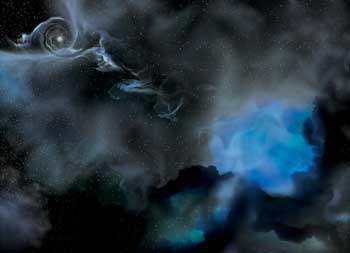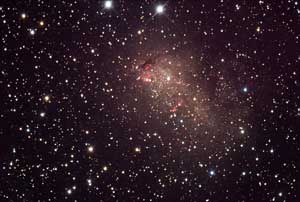During two weeks, two black holes with solar masses were discovered, heavier than all the previous black holes with solar masses that were found * Then a group of scientists, including Prof. Tzvi Mza of Uni' Tel Aviv, announced a black hole of 16 solar masses and today a new record – A stellar black hole of 24 solar masses

The black hole is in the upper left corner and the neighboring star is to its right. Both stars move around the center of gravity once every 34.4 hours. The neighboring star is of the Wolf-Rayet type. Such stars are in advanced stages of development and will end up exploding as a supernova. The black hole's neighbor sheds its outer envelope, and some of the gas is captured by the black hole's powerful gravitational field. Artist: Aurore Simonnet. From the NASA website
Once a world record is set in athletics competitions as a swim or a run, it usually stands for several years before being broken. This procedure is often also valid in astronomical observations, where even decades can pass before a new record is broken. And here, recently two new records were broken - in a period of only two weeks.
Black holes are objects with such a strong gravitational force that nothing can escape them - not even light. Black holes are formed when a star explodes and goes supernova.
On October 17, astronomers announced that a black hole in the galaxy M33 contains a mass 16 times greater than the mass of our Sun. (FYI: A terrifying black hole was discovered thanks to the extraction of material from its partner, a discovery that was also shared by Prof. Zvi Maza from Tel Aviv University, who was also interviewed specifically for the Hidan website). Astronomers used NASA's Chandra X-ray Stargazer (a telescope mounted on a satellite that scans space using X-rays) to locate the new black hole, which was the heaviest yet discovered. It is customary to call such black holes by the nickname "solar-mass holes", because their mass is of the order of magnitude usually found in stars larger than the Sun. The discovery of this discovery was published in science the very next day.
The researchers barely had time to celebrate, when another group announced, in an article published on the first of November, that they had discovered a massive black hole, whose mass is at least 24 times that of the Sun. The group added that the mass of the black hole may be even greater, reaching up to 33 solar masses.
The team is led by Andrea Prestwich of Harvard University's Cambridge Center for Astrophysics and the Smithsonian Observatory. The research team used both Chandra and NASA's Swift satellite to make the discovery.
Prestwich is quick to explain that breaking the record is not that important to scientists. For him, it is much more important to learn something new about the way black holes are formed. "We now know that black holes formed from extinct stars can be much larger than we previously thought," she says. The black hole is located in a small, asymmetrically shaped galaxy known as IC 10. This galaxy is relatively close to Earth, at a 'tiny' distance of 1.8 million light years. The black hole is accompanied by a neighboring star on its journey through space. The two stars revolve around each other. As a result of the black hole's gravity, the neighboring star loses large amounts of gas. Some of the gas is captured by the powerful gravity of the black hole, and it is destined to fall into the black hole and disappear from the world. The gas is circling the black hole at extremely high speed, as it gets closer and closer to the black hole's point of no return, from which it will no longer be able to escape. This speed of movement causes the gas to heat up and emit X-ray radiation.
Using Chandra, Prestwich and her colleagues noticed that this star system emits a high amount of X-rays most of the time, but occasionally the X-rays disappear. To find out why, she pointed the Swift satellite's gamma-ray microscope at the system and observed it for 10 days in November 2006.
During the observations, the team discovered that the X-rays are interrupted in a regular cycle. When the two bodies orbit each other, the neighboring star passes every certain period of time in front of the black hole, hiding it from the Earth - thus blocking the X-rays emerging from it. The phenomenon is reminiscent of a solar eclipse, in which the moon passes between the sun and the earth and blocks its light.
Based on the observations from Swift and the Gemini telescope in Hawaii, Prestwich and her team discovered how fast the two stars are rotating around each other. This information allowed the team to calculate the mass of the black hole. Because there are various uncertainties in the calculations, the team's most conservative estimate was that the black hole's mass was 24 solar masses. The most optimistic estimate sets the mass of the black hole at 33 solar masses. But even on the conservative estimate, IC 10's black hole, which has a mass of 'only' 24 solar masses, is much heavier than the black hole in M33, which has a mass of only 16 solar masses.
The obvious question is: how can this black hole be so big? Computer calculations show that even the most massive stars in our galaxy - the Milky Way galaxy - turn into black holes with masses of 15-20 solar masses at most. Even if these stars began their lives as stars with 100 solar masses, almost all of their mass is scattered into space in the supernova explosions that end their lives, and also before them.

The galaxy IC 10 is an asymmetric dwarf galaxy 1.8 million light-years from Earth.
הThe black hole in the IC 10 galaxy was probably formed by a star with a different chemical composition than the stars in our Milky Way. More precisely, the parent star probably had a very small percentage of elements heavier than hydrogen and helium. These two elements are the easiest of all the elements. Calculations made with the help of the computer show that such stars will disperse less gas before the explosion, so they can create heavier black holes.
Roy Kilgard is Prestwich's fellow at Wesleyan University in Connecticut. Kilgard explains that massive stars in our galaxy probably do not produce supermassive black holes. However, he adds that, “There may be millions of supermassive black holes with solar masses hiding in our galaxy. These black holes were formed early in the history of the Milky Way, before the concentration of heavy elements in the galaxy increased."
Although the black hole from the galaxy IC 10 managed to break the record and crown itself the largest black hole with solar masses, it is still tiny compared to the black holes that exist at the centers of large galaxies. These monsters were created at the beginning of the history of the universe, but we still don't know how. Mastam reaches millions and billions of solar masses, which is why they are known as "supermassive black holes".

10 תגובות
Nonsense
pleasantness,
I believe that the question is better addressed to my father, in one of the last articles about the Discovery.
I have a pretty serious suspicion that there are many more black holes than people think :). Most of them were formed in the early universe.
And some of them are inside the heads of some creationists (otherwise it is impossible to explain how it is that you don't see even a drop of each dripping from them).
No, because someone did a calculation, and it is a difference of orders of magnitude. A few tens or hundreds of black holes will not change the picture.
Avi. Do you have an article that explains why they don't accept the possibility that the missing mass is actually the black holes that are yet to be discovered?
I didn't understand what the problem was that a black hole of such a size was created.. Couldn't it be that it just merged with another black hole star?
A question to Roi Tsuga, the gates he understood in Dikberi to the station are closing today, what does that mean
To Mike - it's clear that it's an illustration, I think I wrote it too.
To burst - interstellar black holes are separate beings from black stars in the centers of galaxies. These are very heavy suns that collapsed in on themselves due to their weight after the end of the era in which they turned hydrogen into helium (which in such stars is very short, up to a few million years). Galactic black holes were created at the beginning of the universe and around them the galaxies formed, and over the years they swallowed gas, dust, stars and also stellar black holes - which are stars for everything, certainly compared to these monsters.
Just as you don't do a running competition between humans and cars, so there is no point in comparing stellar black holes with black holes in the centers of galaxies. Still, that doesn't mean that you shouldn't check how much he got in a 100 meter run and it doesn't mean that there's no point in checking it because a car does it in a second compared to the sprinter who does it in 9 or so seconds.
Perhaps the reference here is to black holes of a certain type, because black holes of the size of 3 million solar masses and even more were discovered a long time ago and published here in the knowledge a few months ago!
I was surprised at the time by the mega astronomical size, but it was repeated in several publications and I even read about it on the Tel Aviv University website until I was convinced that I had indeed missed something important.. because until then all the books I read talked about 3 to 4 solar masses!!
No way
http://www.nasa.gov/images/content/195154main_WRstarBH2.jpg
It's a computerized image, right?
aurore this galactic painter or something
?!?!?!?!?!?!?!?!?!?!?!?!?!?!?!?